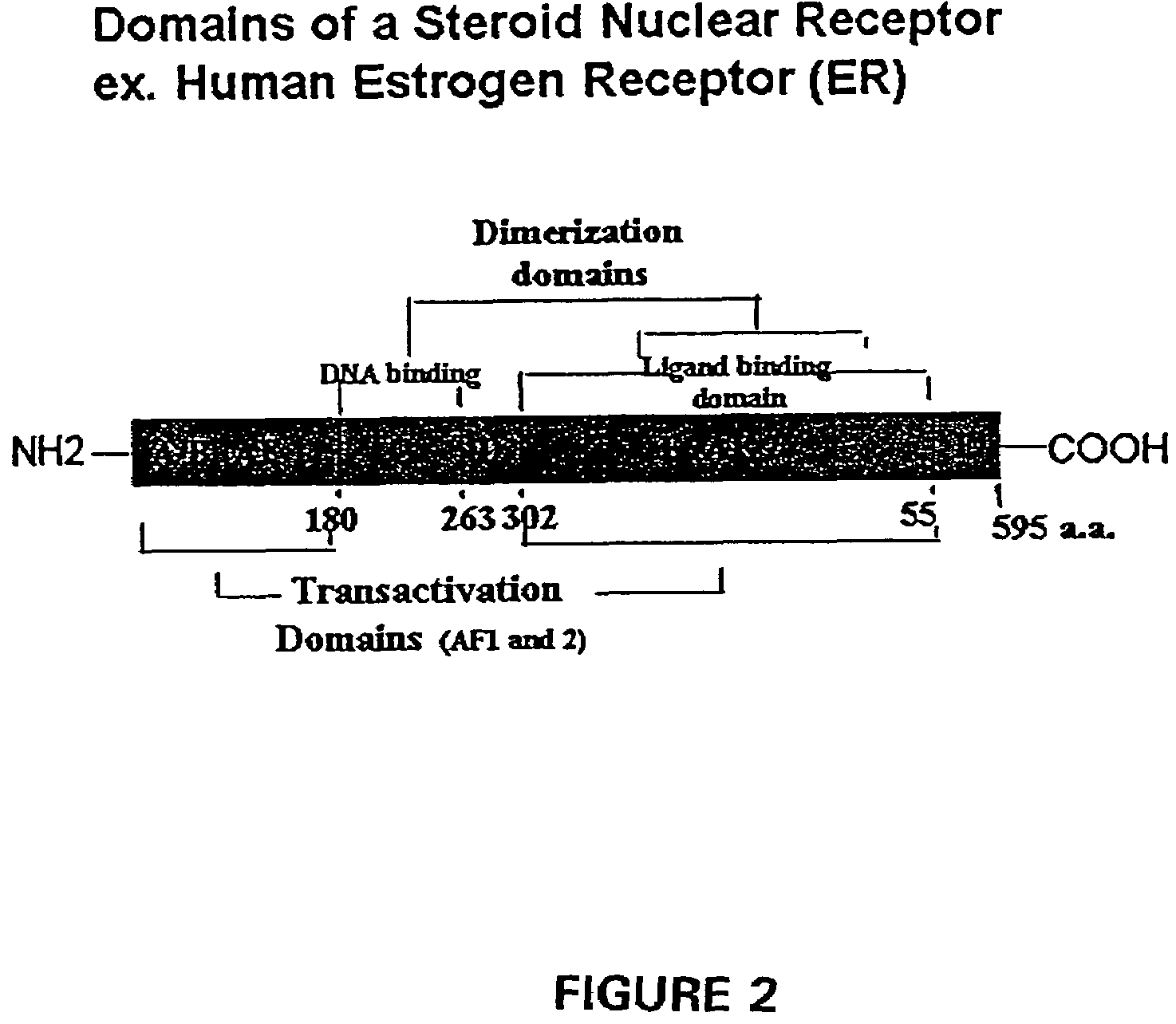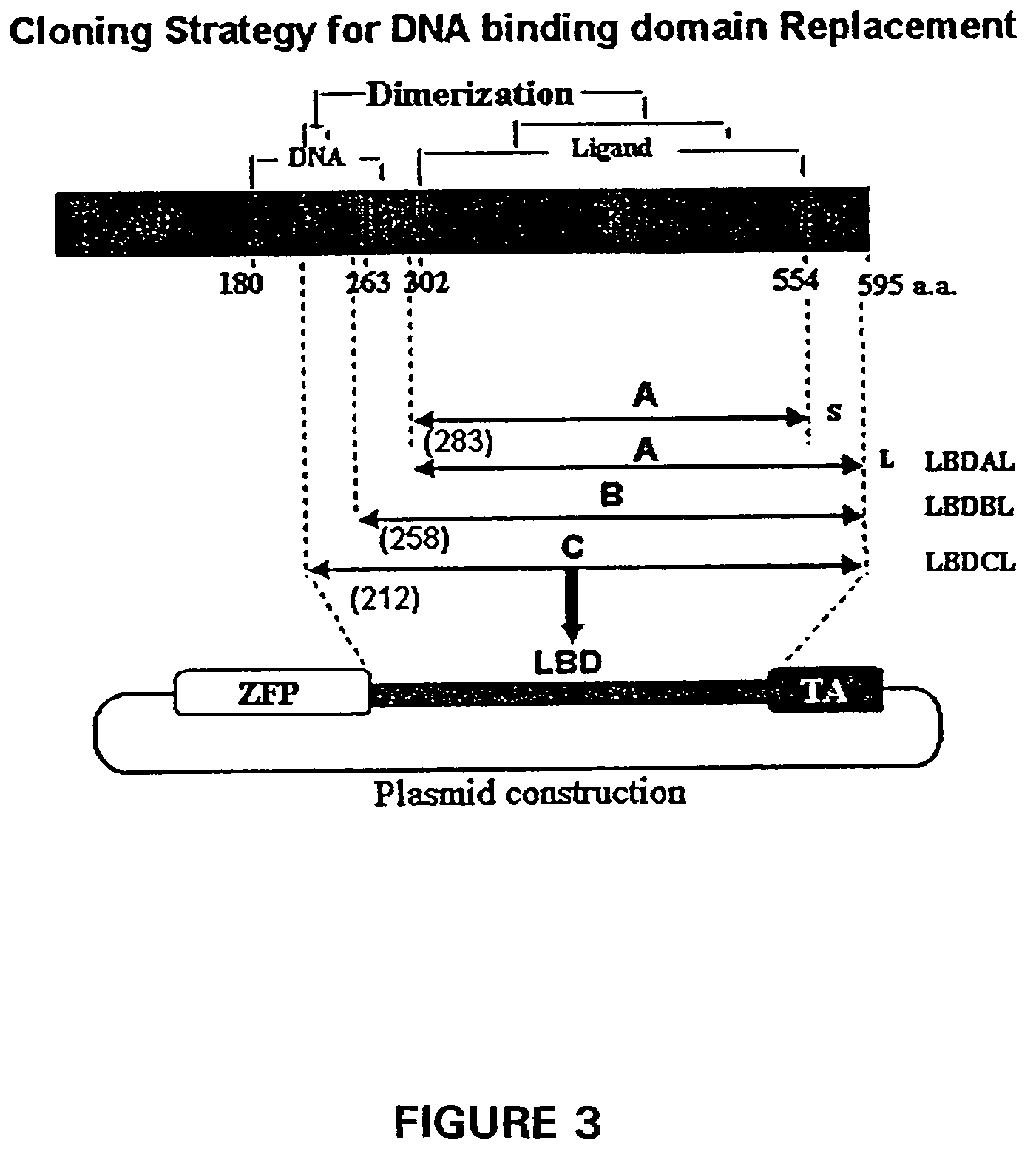Ligand activated transcriptional regulator proteins
a transcriptional regulator and ligand technology, applied in the field of gene expression regulation, can solve the problems of increased zinc finger proteins, unoptimized serial connection of f2 domains,
- Summary
- Abstract
- Description
- Claims
- Application Information
AI Technical Summary
Benefits of technology
Problems solved by technology
Method used
Image
Examples
example 1
Construction and Testing of Designed Specific Zinc Finger Domains
[0266]Variant zinc finger proteins have been designed and constructed to selectively bind to specific DNA sequences (Table 1). Table 1, below, summarizes the sequences (SEQ ID NO: 77-92) showing the highest selectivity for the sixteen embodiment of GNN target triplets.
[0267]
TABLE 1TargetAmino acids positionsSpecificity−1 1 2 3 4 5 6SEQ ID NO:GAAQ S S N L V R77GACD P G N L V R78GAGR S D N L V R79GATT S G N L V R80GCAQ S G D L R R81GCCD C R D L A R82GCGR S D D L V K83GCTT S G E L V R84GGAQ R A H L E R85GGCD P G H L V R86GGGR S D K L V R87GGTT S G H L V R88GTAQ S S S L V R89GTCD P G A L V R90GTGR S D E L V R91GTTT S G S L V R92
[0268]Oligonucleotides for Zinc Finger Library Panning
[0269]Biotinylated, hairpin-structured target site oligos for panning of finger 2 (“F2”) libraries had the following sequence:
F2XXX:
5′-Biotin-GGA CGC N′N′N′ CGC GGG TTTT CCC GCG NNN GCG TCC-3′ (SEQ ID NO: 25) where NNN=either of the 16 triplets o...
example 2
Construction of Fusion Proteins Containing Zinc Finger Domains and Transcriptional Repressors and Activators
[0310]In order to demonstrate use of zinc finger proteins as gene-specific transcriptional regulators, the E2C(Sp1), B3B(Sp1), and B3C2(Sp1) six-finger proteins were fused to a number of effector domains (Beerli et al. (1998) Proc. Natl. Acad. Sci. U.S.A. 95:14628-14633). Transcriptional repressors were generated by attaching either of three human-derived repressor domains to the zinc finger protein. The first repressor protein was prepared using the ERF repressor domain (ERD) (Sgouras et al. (1995) EMBO J. 14:4781-4793), defined by amino acids 473 to 530 of the ets2 repressor factor (ERF). This domain mediates the antagonistic effect of ERF on the activity of transcription factors of the ets family. A synthetic repressor was constructed by fusion of this domain to the C-terminus of the zinc finger protein.
[0311]The second repressor protein was prepared using the Krüppel-assoc...
example 3
Fusion Protein Construct Comprising Progesterone Receptor Variant
[0320]Amino acid sequence comparisons of steroid receptor family members indicates that they generally comprise a number of defined domains, including an N-terminal DNA binding domain and a more C-terminally located ligand binding domain. Importantly, these domains are modular and the DNA binding domain of progesterone receptor (PR) has been successfully exchanged for the Gal4 DNA binding domain. The addition of a VP16 activation or a KRAB repressor domain to the N- or C-terminus of this construct yielded proteins that could regulate a Gal4 responsive reporter in a ligand dependent manner. An important feature of the ligand binding domain used in these studies is that it is derived from a mutant PR with a small C-terminal deletion. This mutant fails to respond to progesterone and is responsive only to progesterone antagonists such as RU486, making this system suitable for in vivo applications.
[0321]The original PR DNA ...
PUM
| Property | Measurement | Unit |
|---|---|---|
| Dissociation constant | aaaaa | aaaaa |
| Molar density | aaaaa | aaaaa |
| Molar density | aaaaa | aaaaa |
Abstract
Description
Claims
Application Information
 Login to View More
Login to View More - R&D
- Intellectual Property
- Life Sciences
- Materials
- Tech Scout
- Unparalleled Data Quality
- Higher Quality Content
- 60% Fewer Hallucinations
Browse by: Latest US Patents, China's latest patents, Technical Efficacy Thesaurus, Application Domain, Technology Topic, Popular Technical Reports.
© 2025 PatSnap. All rights reserved.Legal|Privacy policy|Modern Slavery Act Transparency Statement|Sitemap|About US| Contact US: help@patsnap.com



